
Abstract:
Women with disabilities are among the most
marginalized and neglected groups of people
in developing countries. This study examined
the association between disability status and
ever experiencing intimate
partner violence (IPV) among women in Uganda,
with disability status as a key explanatory
variable. The determinants of emotional,
physical, sexual, and any intimate partner
violence were assessed among women with
disabilities compared with women without
disabilities. In both cases, we adjusted for
women’s characteristics and partners’
behavioral factors.
The study, which was based on data from the
2016 Uganda Demographic Survey (UDHS), used a
weighted sample of 6,879 cases of currently
married and ever-married women selected for
the survey’s domestic violence module. We
used chi-squared tests and multivariate
logistic regressions to examine the
determinants of IPV, with disability status
as the main explanatory variable and,
thereafter, determinants by disability
status. Other key explanatory variables
included witnessing parental violence and
spousal
behavioral factors. Findings show that the
unadjusted associations between emotional,
physical, and sexual violence and disability
status were statistically significant, in
that women with disabilities had higher odds
of experiencing the three forms of IPV
compared with women without disabilities. The
odds of IPV remained high and significant for
emotional and sexual violence after adjusting
for women’s characteristics. Certain
spousal behaviors, namely getting drunk and
controlling their partners, had a stronger
influence and consistently increased the odds
of all three forms of IPV for women with or
without disabilities. Women’s
witnessing parental violence and fearing
their spouses also consistently increased the
odds of emotional and sexual IPV both for
women without disabilities and with
disabilities. Additional risk factors for
women
with disabilities were urban residence, for
emotional IPV; and Catholic religion,
residence in Central region, and agricultural
or manual work, for sexual IPV. In the
Ugandan context, key determinants of
emotional, physical, and sexual intimate
partner violence among women, with or without
disabilities, are mainly associated with
partners’ behaviors and a history of exposure
to parental IPV. Preventive measures against
IPV should prioritize these factors. Apart
from these, determinants of the different
forms of intimate partner violence vary by
women’s disability status; therefore, each
group should be considered separately. For
women with disabilities, additional attention
should be paid to emotional IPV among urban
residents and to sexual IPV among women in
agricultural and manual work, Catholics, and
residents of Central region.
 Disability, Partner Behaviors, and the Risk of Intimate Partner Violence in Uganda: Further Analysis of the 2016 Demographic and Health Survey (PDF, 627K)
Disability, Partner Behaviors, and the Risk of Intimate Partner Violence in Uganda: Further Analysis of the 2016 Demographic and Health Survey (PDF, 627K)
